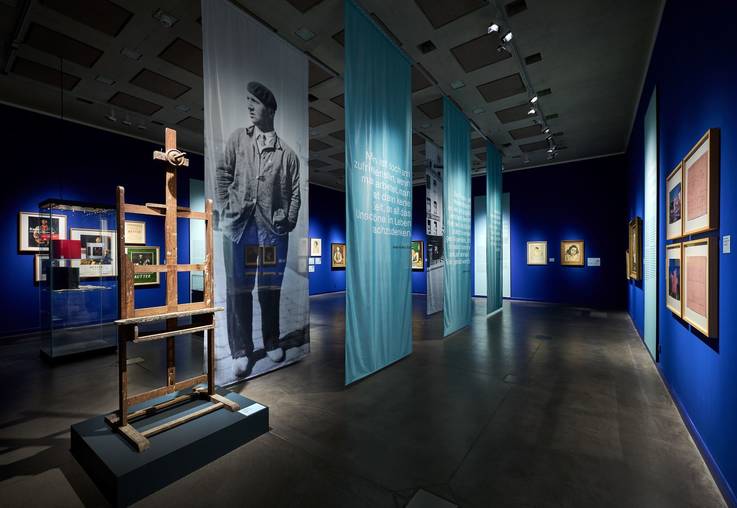As our current exhibition on the many faces of Joseph Kutter demonstrates, the ties between the Nationalmusée and Kutter have always been strong.
Indeed, this marks his fifth solo show at the museum. Looking at these exhibitions and their context not only illustrates how the museum played a crucial role in establishing Kutter in the canon of Luxembourgish art, but might also give insights into how he was used to solidify and celebrate a sense of national identity after the Second World War.
The first way to approach these questions would be to compile source material on the exhibitions and to read it closely. This might include exhibition reviews, texts from the exhibition catalogues or archival documents. Such documents tend to exist in physical form, especially in the case of exhibitions staged before digital communication and media became the norm, where correspondence wasn’t yet done by email and reviews weren’t published online.
However, the fact that some of them have been digitised makes them easier to find and access. The reviews of the exhibitions published in Luxembourgish newspapers, for example, can be found on the National Library’s website eluxemburgensia.lu which provides access to a great number of digitised Luxembourgish periodicals. The museum’s Library Department has also digitised all the exhibition catalogues published by the museum through to 1980 (the others will be digitised in the following year) and made them available on the platform MNAHA Collections. Among them are the catalogues of the first two Kutter exhibitions from 1946 and 1961. These digital resources make it easier to conduct traditional research based on engaging directly with the source material.

The potential of digital
Yet, the availability of digital data also allows us to approach the source material in a different way and answer different questions. We could, for example, study the reception of Joseph Kutter at the Nationalmusée by using the available metadata on the museum’s collection and past exhibitions.
Having this data in digital form not only facilitates qualitative study, but also enables quantitative analyses. It can help us answer questions such as how has the Kutter collection grown over time? What percentage are paintings and what percentage are drawings? Which works were exhibited in what exhibition? Which works were exhibited often, which have not been exhibited at all? How many of the works on show were part of the museum’s collection at the time, and how many works on show in each exhibition are part of the museum’s collection today? The answers to these questions can be analysed and interpreted, telling us more about both Kutter’s and the Nationalmusée’s history.

The magic of metadata
The data on Kutter that we need to answer these and many other questions has been gathered and encoded as part of our ongoing effort to publish our collections online on MNAHA Collections. You can find our entire Kutter collection on there and each work is described by selected metadata, i.e., the type of work, dimensions and medium, but also the date and method of acquisition. Since Kutter’s works are in the public domain you can download high-resolution images of his works, zoom in closely and analyse his technique or even print them out and hang them on your walls.
Because objects are much more telling when they are put into context, we didn’t just encode data about individual works, but we linked them to the exhibitions they were a part of. As a part of our efforts to both better understand our collection and our institutional history, we have started to publish our past exhibitions on MNAHA Collections. For each exhibition we try to reconstruct the physical exhibition as far as we can by assembling the works from our collection that were exhibited, the exhibition catalogue, scans of installation views – if they exist – and a reference to our archive, where more, not yet digitised documents can be found and requested. As such, the digital platform doesn’t question the importance of archival research, but rather offers an accessible tool that facilitates substantive preliminary research. MNAHA Collections is designed to display the works, their data and context in a way that is intuitive and easy to read.
However, the data is not necessarily presented in a form that someone who doesn’t have the necessary technical skills can easily make use of. To make it more accessible, we have decided to publish thematic datasets on the data sharing platform of the Luxembourg state – data.public.lu. The first dataset is on the works of Joseph Kutter in our collection and their exhibition history. It is the same one I will be using to prepare the talk Lis Hausemer and I will give on Kutter’s reception at the Nationalmusée in July. We will use both methods described above to look at how the museum both canonised Kutter and used him as a symbol of national identity.
Text: Edurne Kugeler - Images: Tom Lucas
Source: MuseoMag N°II 2024
Be sure to sign up for the talk De Joseph Kutter an der Geschicht vum Nationalmusée with Edurne Kugeler and Lis Hausemer on 4 July at 6 pm, organised as part of our exhibition Dem Kutter seng Gesiichter. Nei Facettë vun eiser Sammlung.
